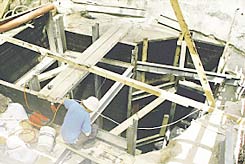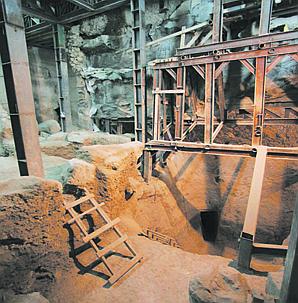New Ancient Mud Bricks for the Tel Dan City Gate

The Middle Bronze Age city gate
Photo source: Avihu Shapira for ynet ynet (Hebrew) reported on Monday on renewed restoration effort at the Middle Bronze Age gate (contra article, which refers to it as the Late Bronze Age gate) at Tel Dan. The current stage of restoration, to last 10 days, involves building new mud bricks using ancient techniques. A translation follows:
The City Gate - Reconstructing History
by Hagai Einav
At Tel Dan this morning, experts began the third and central stage in the reconstruction of a gate initially built during the Late Bronze Age, considered to be one of the most important 13 sites in archaeology.
Great excitement was felt Monday amongst the representatives of the Israeli Nature and Park Authority and the Israeli Antiquities Authority in the north, as the third and central stage in the restoration of the "City Gate", built approximately 1500 BCE, in the area where the Tel Dan Park resides today in the Upper Galilee and which is considered an important discovery even amongst international experts.
...
The story begins in 1980, when the first signs are discovered of what is considered today to be one of the 13 important archaeological monuments. This is a gate, initially built during the Late Bronze Age, and which served for a long time those who entered the Biblical city found at the site of today's Tel Dan Park.
Elyakim Maman, a restorer from the Nature and Parks Authority in the north, described the uniqueness of the current "City Gate:" "It is an architectural structure with three arcs, one in the front, another in the inside section, and a third in the back. The gate stands 7 meters tall and its uniqueness lies in the use of such building technology at such an early time. The excavation of the site, its restoration, and its conservation are generating great interest across the world, and for us who are working to conserve the site. This is a very important and exciting moment."
In the first two stages, the appropriate type of earth was selected for the conservation work. In the second stage, a temporary wall was built, that withstood the test of time including withstanding extreme weather in the summer and winter. During the next ten days, the third stage will take place whereby the conservation workers of the Nature and Parks Authority, under the guidance of the Israeli Antiquities Authority, will create mud bricks for the restoration and conservation of the southern tower in the gate. 
New mud bricks made for the restored gate.
Photo source: Avihu Shapira for ynet
"One of the main problems with which we are dealing during the restoration is the slanting of the frontal tower forward and this requires complex work and great technical expertise," says Maman.
Hundreds of visitors and pilgrims visited the site Monday and one of the groups even saw the mudbrick making process up close, leading them to sing with great excitement at the impressive gate. The park workers hope that as a result of restoration of the gate and news of the excavation of the "City Gate", many pilgrims and visitors will come to visit the site at the center of the Galilee.
Related Links:
- IAA Tel Dan Conservation site (English with summary and photos)
- Tel Dan Nature Reserve site
- ynet news report (Hebrew w/ photos)
- Virtual Tour of Tel Dan
References:
- Biran, Avraham. Biblical Dan. Jerusalem: Israel Exploration Society and Hebrew Union College - Institute of Religion. 1994. Hide Reviews
- Eades, Keith L. "Review of Biblical Dan, by Avraham Biran". Journal of Biblical Literature 115/4 (1996): 724-726.
- Emerton, John A. "Review of Biblical Dan, by Avraham Biran". Vetus Testamentum 44/3 (1994): 418-419.
- Jacobs, Paul F. "Review of Biblical Dan, by Avraham Biran". Journal of the American Oriental Society 116/1 (1996): 139-140.
- Leibowitz, Harold. "Review of Biblical Dan, by Avraham Biran". Bulletin of the American Schools of Oriental Research 308 (1997): 100-102.
- Biran, Avraham. "The Discovery of the Middle Bronze Age Gate at Dan". Biblical Archaeologist 44/3 (1981): 139-144.
- Biran, Avraham. "The Triple-Arched Gate of Laish at Tel Dan". Israel Exploration Journal 34 (1984): 1-19.



